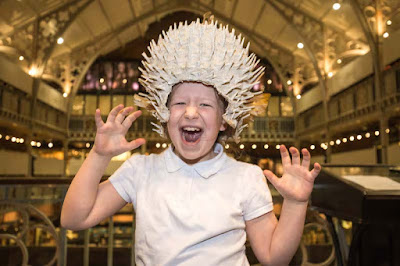 |
| Replica Porcupine Fish Helmet © Pitt Rivers Museum |
What did we do at the Pitt Rivers?
As the Primary School Education Officer I worked with a Year 4 and a Year 5 class from both St John Fisher Catholic Primary School and St Andrews CofE Primary School. Each class visited the Museum twice with a gap of two weeks to allow the pupils to prepare their presentation on key items in the collection. During the first visit pupils focused on one object and explored lots of different ways of engaging audiences with that object. The object we chose to look at was the porcupine fish helmet from Kiribati, a group of Pacific islands. Pupils had a great time trying on a replica helmet, modelling their own fish helmet from plasticine and asking a range of questions. I particularly liked the questions: Was the fish killed while puffering? Did you steal this object? and Do you need gloves to pick it up?
 |
| Plasticine Helmets © Pitt Rivers Museum |
In small groups pupils were then allocated an object in the collection which they had to research and go away and prepare a multi-sensory presentation on. By working closely with the class teachers we were able to choose objects which matched their classroom topic. One class explored Mythical Beasts so we discovered hippocampi (Greek mythological sea-horses!) and dragon serpents lurking in the Museum, whilst another class explored Ancient Egyptian artefacts.
 |
| Spotting an Ancient Egyptian 'pencil' case in the Museum © Pitt Rivers Museum |
In the second visit pupils gave their presentations which were incredibly fun and engaging. I had modelled different ways of engaging visitors with an object in the first session but they seemed quite sedate in comparison to what the pupils produced! We experienced Egyptian dances, listened to raps, watched stop motion films, helped to create a lion's mane and all had a go at making origami frogs. It was a great pleasure to see the pupils owning the Museum space and having the confidence to present and perform in a public arena.
 |
| Preparing a person for mummification in Ancient Egyptian presentation © Pitt Rivers Museum |
Finally, pupils had the opportunity to meet a real curator, Faye Belsey, who told us a bit more about what goes on behind the scenes in a Museum. Pupils found out how objects get organised and recorded whilst also discovering how they are protected from hungry insects - they should all know what moth poo looks like now having had a hands-on experience!
 |
| Handling moth poo! © Pitt Rivers Museum |
What now?
This pilot project enabled museum education staff to work alongside primary school teachers to explore how museums can be used to support learning in a cross curricular way. We hope it will pave the way for schools to access the collections of their local museums in a creative way when exploring a classroom topic. Objects really can bring topics to life and if those objects are nearby why not go and see them?
If you would like to discuss ideas for a possible Curious Curator session please contact rebecca.mcvean@prm.ox.ac.uk
Becca McVean
Education Officer (Primary)
No comments:
Post a Comment